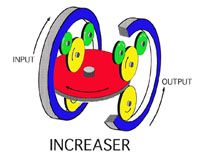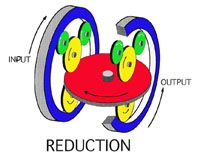
One ring is connected to the engine and transmits power through two paths to the transversely mounted disc. The first path is from the ring to the planet roller contacting the disc. The second path is from the ring through two idler rollers contacting the sun roller, which in turn contacts the disc. Depending on the direction of power flow and the amount of torque, one of the idler rollers moves into the converging gap of the ring to establish enough clamping force to prevent slippage of the contacts.
 The velocity of the inside of the ring is thus transferred to the disc at a radius that is dependent upon the position of the center of the disc. When the input contact is at a small radius, the disc turns fast. The output velocity is increased. The velocity of the inside of the ring is thus transferred to the disc at a radius that is dependent upon the position of the center of the disc. When the input contact is at a small radius, the disc turns fast. The output velocity is increased.
 When the input contact is at a large radius, the disc turns slowly. The output velocity is reduced. When the input contact is at a large radius, the disc turns slowly. The output velocity is reduced.
The second planetary works in a similar manner except that the power is transferred to the output ring instead of from the input ring. When the disc is in a position where the radius to contact is small, the output ring turns slowly. When the disc is in a position where the radius to contact is large, the output ring turns fast.
Thus, any speed ratio between the slowest to the fastest is achieved by positioning the disc. Actually, power being passed through the unit is used to steer the disc to any ratio selected, thereby using very little power compared to the power needed for other systems.
|